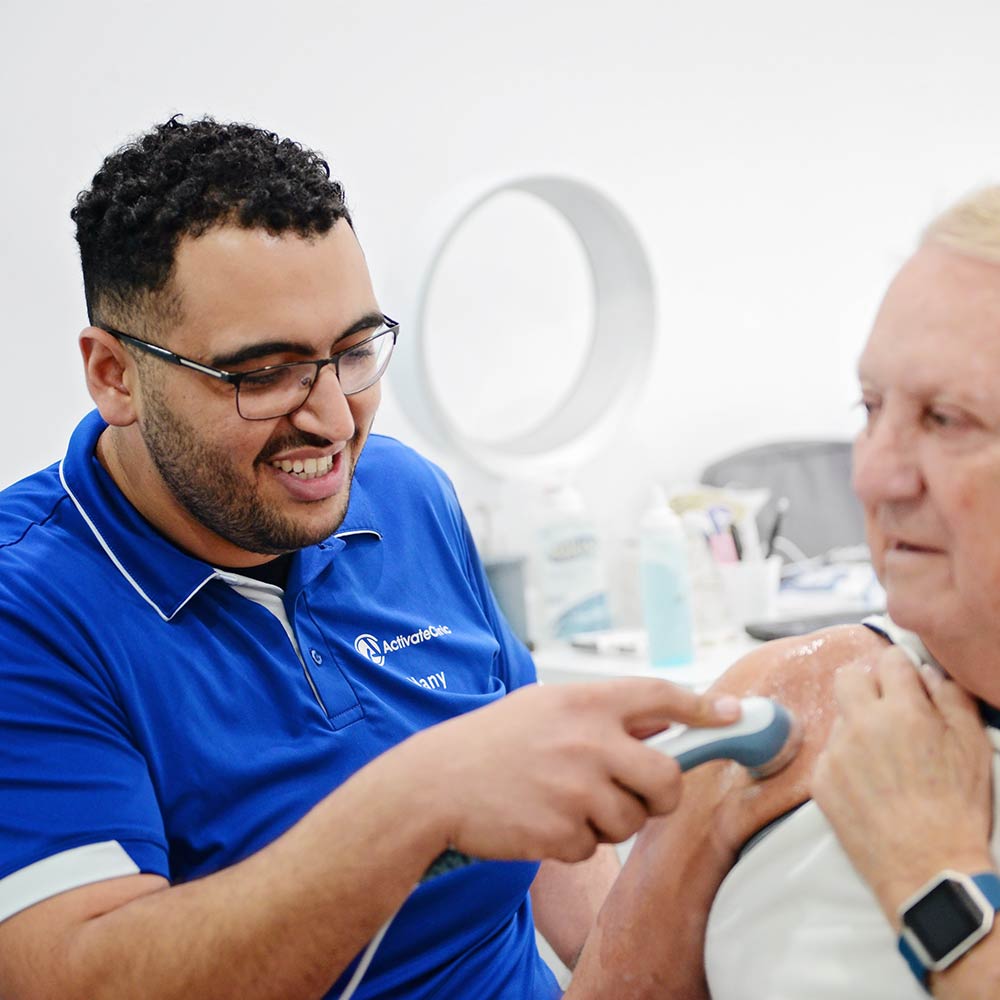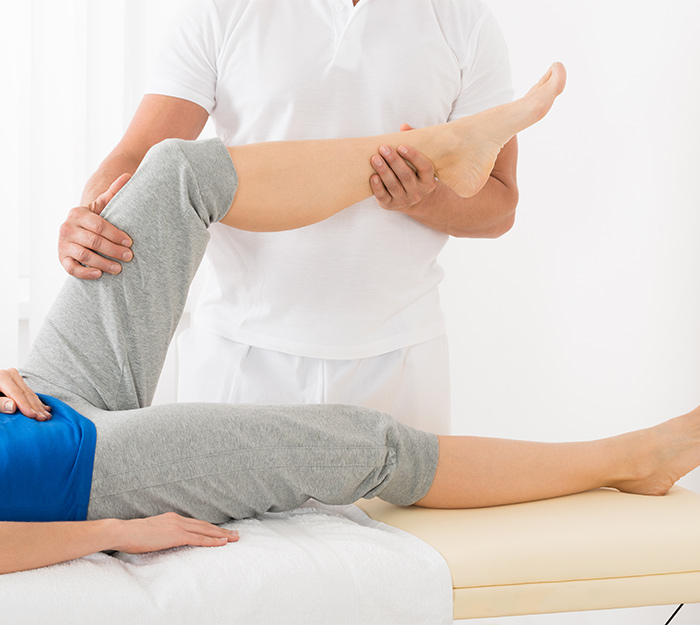Don't let
KNEE PAIN
Hold You Back!
WHAT CAUSES KNEE PAIN?
The short answer: the cause of knee pain is very individual from our experience. Our clinic assesses each person individually in order to identify the specific mechanism of knee pain. Sometimes it can be easy to identify and sometimes it can be a little more complicated.
In general, knee pain is usually caused by the following factors:
1. Muscle Weakness
There are many muscles that act on the knee and it is the primary role of the muscles to maintain the space in the knee joint. It would be safe to say that most of the knee pain cases that we see at Activate Clinic involve an element of muscle weakness.
It’s important to note that “weakness” is relative to what kind of stress the knee joint is put through on a daily basis. Going up/down stairs, walking, running, squatting, kneeling, standing are all movements that require strength and endurance of the muscle.
For example, you may be very strong but if your job requires you to walk 10km’s per day, or stand on your feet all day, your muscles need to be strong enough to handle that stress.
We excel at diagnosing and prioritising your specific muscle weaknesses and helping you develop a plan & strategy to strengthen those muscles, and reducing the amount of friction your knees have to go through.
2. Muscle Tightness
Muscle weakness usually leads to muscle tightness. Tight muscles are another major factor when we identify the cause of knee pain. Since there are 3 major groups of muscles that cross the knee joint, having tightness in the quads, hamstrings or calves can lead to less joint space and aggravate knee pain.
The solution for tight muscles is to take steps at stretching and lengthening the muscle. The challenge is that it takes many repetitive movements over many days to adequately lengthen the muscles but with proper identification and effective exercise choices, we can help you improve muscle tightness and thus reduce knee pain for good!
3. Patella (Kneecap) Maltracking
Patellofemoral issues are some of the primary contributors to knee pain. Patella maltracking refers to the kneecap moving over the rough part of the bone rather than the smooth area it’s intended to glide over. The rough, repeat friction causes damage on the back of the kneecap and can be extremely painful.
Patella maltracking can be easy to diagnose but solving the problem involves stretching specific muscles in the quadriceps and releasing fascia in the outside of the thigh.
We can usually have an immediate impact of patella issues by providing strategic exercises to be done throughout the day that will correct the issue without the need for medicine or surgery!
4. Incorrect Movement Patterns
In many cases, knee pain occurs as an overuse injury. Overuse is especially common when movement patterns are incorrect. Some of the major culprits we see are:
- Poor squatting technique
- Incorrect walking technique
- Compensation due to other injuries
- Poor balance
In our experience, there have been cases where just merely correcting how a person walks, knee pain can be drastically reduced by restoring the correct dynamics to the movement.
WE WANT TO HELP YOU
Hi, I’m Hany, the Clinic Director.

Since we launched Activate Clinic we have helped people take the pressure off the knee joint and reduce their pain. Having gone through knee pain myself, I can understand how annoying knee pain can be and how much it can really affect every day life.
Our motivation is to help you live pain free so you can go back to focusing on the things that really matter in life
We understand that there is a lot of information out there and you may have already tried to solve the problem and not enjoyed a lasting result. We are confident that our programs will work for you because our expertise is in correctly diagnosing the underlying issues giving us an advantage to provide you with amazing treatment at amazing prices.
I’m looking forward to helping you and your knees!
WHAT TO EXPECT FROM THE INITIAL ASSESSMENT
Part 1: Understand your pain & history of pain
We believe that everyone is unique.
What follows is that every injury is also unique. The pain may be in a similar area but each person has a specific trigger to their pain.
The initial assessment goes through a thorough analysis of your pain, history of pain and mechanism of pain to identify potential causes for the pain.
We will assess your muscle strength, flexibility, walking mechanics and all the other potential factors for your knee pain. We will also look at the ankle and hip to ascertain their impact on your knee problem.


Part 2: Physical Assessment
This is the part that really helps us get amazing results…the Physical Assessment.
We often find that traditional medical imaging (X-rays, ultrasounds, MRI’s etc) do not properly diagnose and explain your pain. That’s why we conduct a comprehensive physical assessment to identify which muscles are not functioning correctly.
By using our experience and knowledge of the human anatomy, we can explain to you why you are having pain in the first place. This helps us create a specific and effective treatment plan for you.
Part 3: Restoring Normal Muscular Function
We know that restoring pain free range of motion might seem like our job is complete but as we know, frozen shoulder occurs due to chronic inflammation in the rotator cuff muscles. Therefore, returning to a full, pain free range of motion is not the end of our treatment as you will likely have a set back as soon as you put any load on your hands (such as grocery bags, hairbrush or hanging clothes on the line).
We’ll help you begin the process of restoring normal muscle function by prescribing specific exercises that help improve the key muscles acting on the shoulder.
Just like range of motion, restoring muscle function must be a gradual progression and there are no shortcuts. If you push too much too soon then the muscles will inflame and you will be set back. We’ll help provide clear exercise diagrams and instructions so you can continue treatment from home.
In most cases we use our supervised sessions to see where your progress is at and then we prescribe exercises for home to continue improving the areas required.


Part 4: Return to normal activities
Once we’ve helped you restore pain free range of motion and normal muscular function you are cleared to return to normal activities…yay!
We will continue to support you so we can adjust and provide maintenance exercises and stretches that will assist you prevent re-injury.
OUR LOCATION
98 Park Road, East Hills
- Off-street parking available
- Directly opposite East Hills Train Station
Car: The clinic is 5 minutes from the Henry Lawson Drive exit on the M5 motorway. We have off street parking available around the back of the building.
Train: We are directly across the road from East Hills train station which is on the T2 Airport Line (35 minutes from the CBD and 25 minutes from Campbelltown)
Bus: The 924 and 925 services connect our clinic with Bankstown and Lidcombe.
Your first session is free! Book now!
Not sure what you need? Please feel free to call us on 1300 289 798 or send us an enquiry instead.
